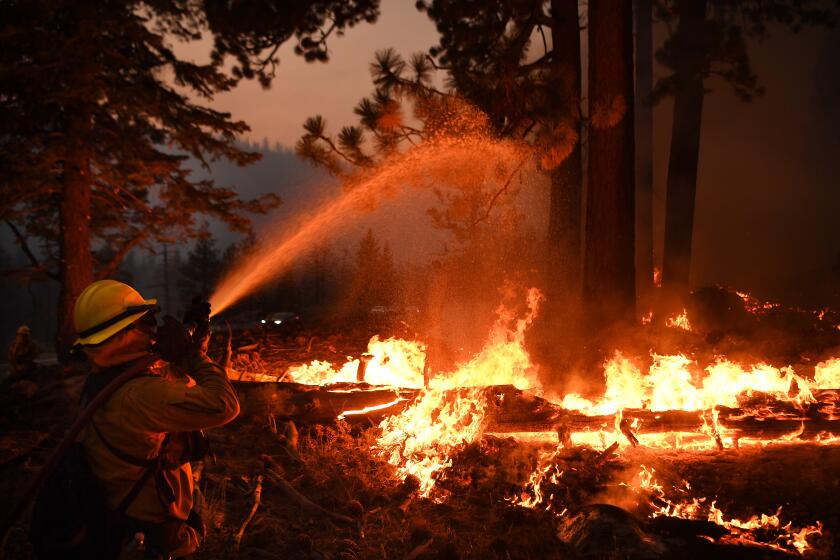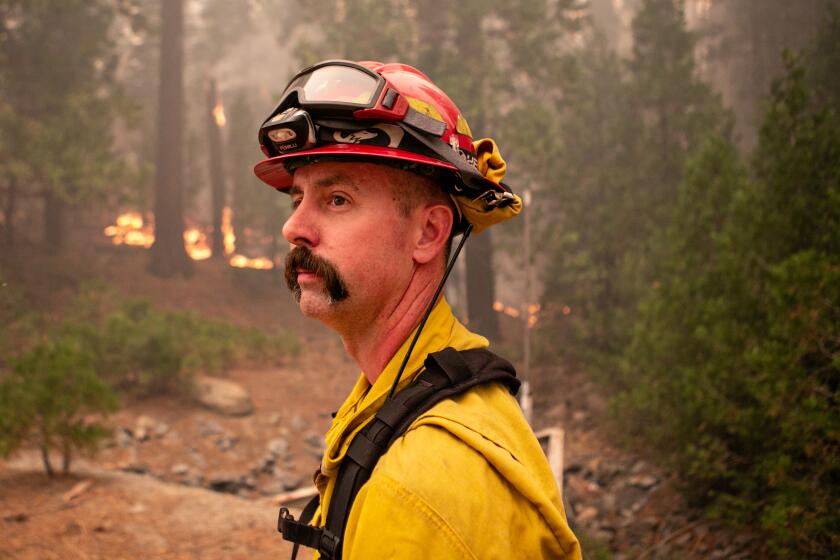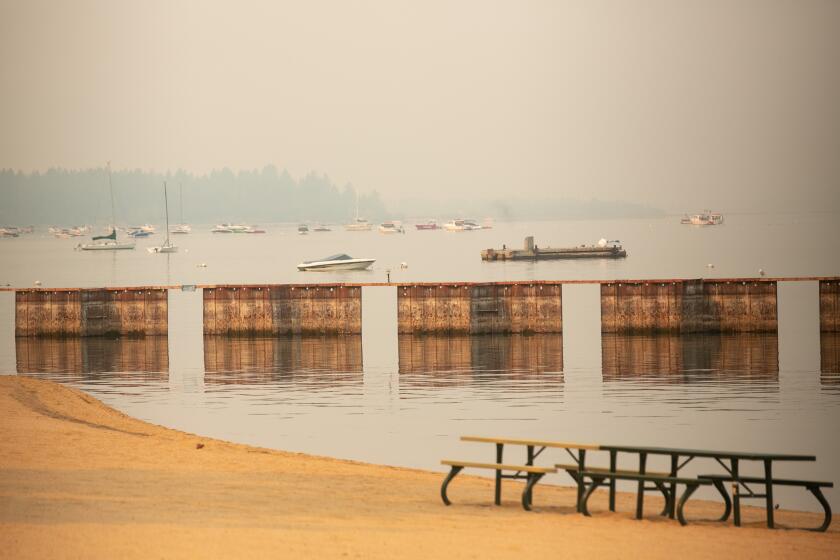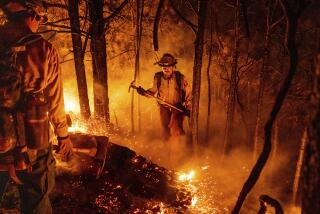As Caldor fire closes in on Lake Tahoe, crews scramble to prevent worst-case scenario
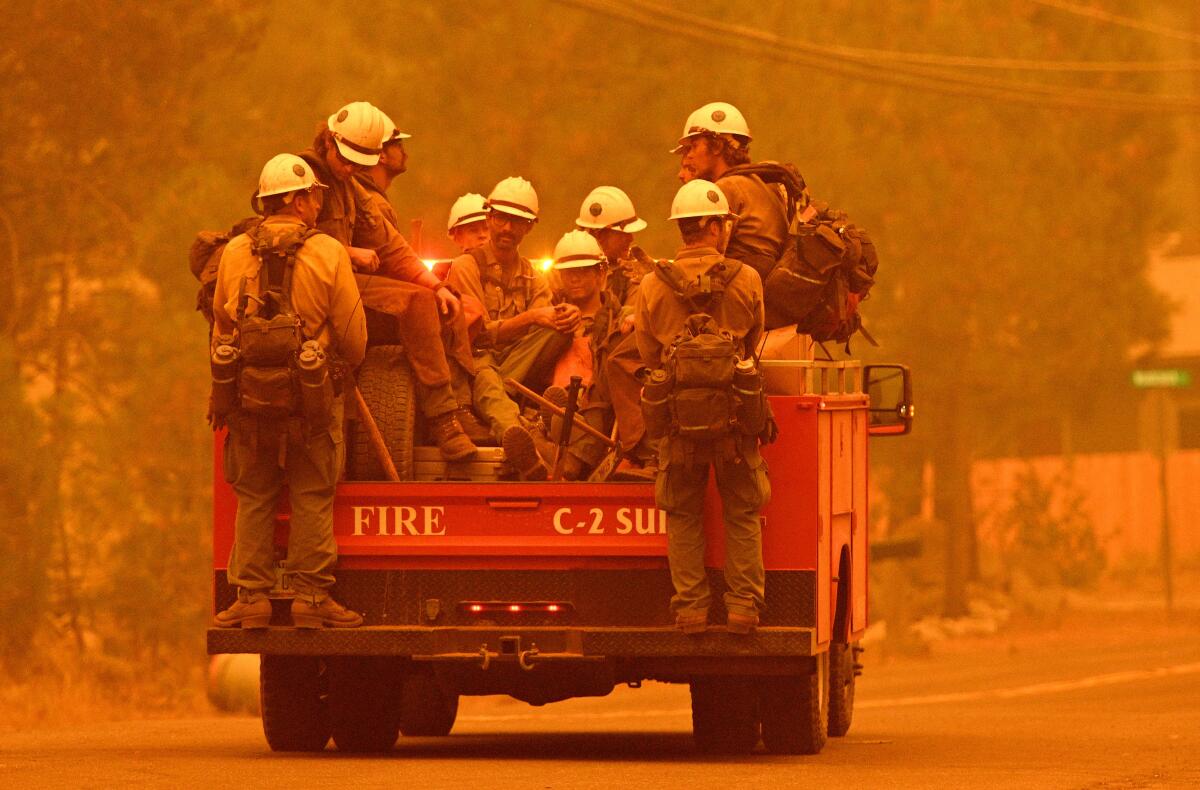
It was a moment officials hoped would never come: The mass evacuation of South Lake Tahoe in the face of a rapidly approaching wildfire.
Even though the Caldor fire had been creeping ever closer to the famed resort town for days, few residents thought it would actually arrive. Most spoke reverently of a towering granite ridge a few miles away that they believed would prevent flames from dropping down into the Lake Tahoe Basin.
By Monday morning however, the wind-whipped fire had made alarming progress, raising the specter of an uncontrolled urban fire and sending residents fleeing under mandatory evacuation orders.
“Today’s been a rough day, and there’s no bones about it,” Eldorado National Forest supervisor Jeff Marsolais said.
Thousands rushed to leave South Lake Tahoe as the resort city came under an evacuation order due to the Caldor fire.
The evacuation comes amid a summer of extreme fire behavior, as heat, drought and wind stoke flames and strain the state’s firefighting capabilities. In response to the crisis, the U.S. Forest Service announced Monday that it would close all national forests in California for roughly two weeks, beginning at 11:59 p.m. Tuesday. The Pentagon agreed to send hundreds of U.S. Army personnel to help battle flames in Northern California.
The Tahoe evacuation order covers nearly all of the Lake Tahoe Basin in El Dorado County, from the California-Nevada state line on the lake’s southern end to Tahoma on its western shore.
For nearly a week, the area had been choked in eye-burning smoke and a layer of ash thick enough to leave footprints. The vacationers who typically populate Tahoe each summer had long since abandoned recreation plans, while swarms of gnats and flies swooped down from the fire’s edge, suggesting that even the bugs were leaving town.
Whether the Caldor fire reaches South Lake Tahoe remains to be seen, and firefighters are working fast and hard to prevent a worst-case scenario.
But the strong winds moving into the area — along with the severe dryness of the state’s terrain — are a recipe for catastrophe. Not only would an urban conflagration in the South Lake Tahoe area threaten lives and homes — it would also move faster, burn hotter and be significantly harder to fight, according to experts.
“They have long looked to that granite wall as what’s going to keep fire out,” said Crystal Kolden, a fire scientist at UC Merced. “But this is a new world with climate change, and that basically is no longer a viable last line of defense.”
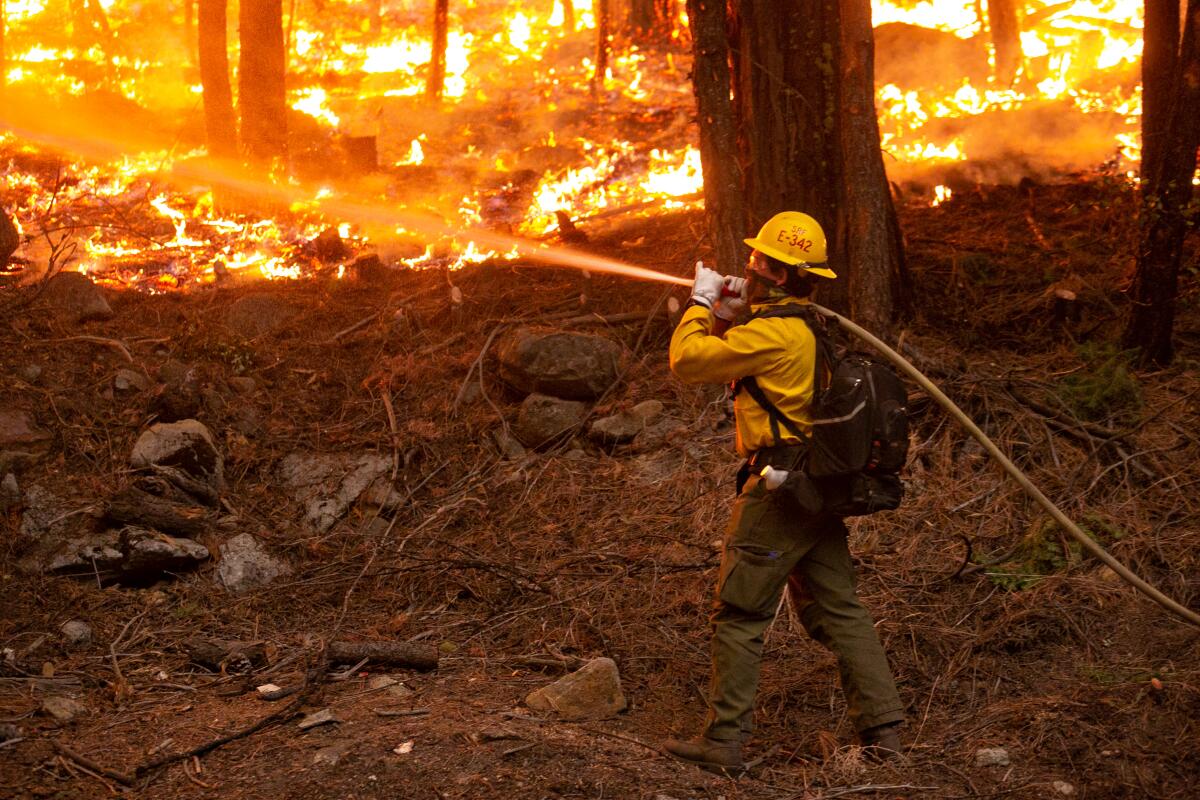
So far, the Caldor fire has primarily fed on vegetation, Kolden said; but if the fire makes it into nearby communities, that will rapidly change. Homes and other structures would not only provide additional fuel for the fire, but also release dangerous chemicals into the air, along with “tremendous embers.”
“It’s an Alpine community with log cabins, and a lot of those structures were built in the ’40s, ’50s, and ’60s,” she said. “So you’ve got this potential for it to really start jumping from building to building to building, and it’s just a completely different beast and they can’t fight it.”
Wildland fires can typically burn up to about 1,500 degrees, Kolden said, while structure fires can burn closer to 3,600.
“It’s so dangerous, it’s so toxic, and there’s so much heat,” she said.
Residents in the basin were tracking the fire’s movement for days, with many hunkering down with air purifiers to mitigate yellow-gray smoke. Some said they were concerned that a mass evacuation would lead to chaos, as much of Highway 50 is closed and there aren’t many roads out of Tahoe.
On the front lines of battle to keep Caldor fire from hitting Lake Tahoe
Already on Monday, the were reports that the highway was more like a parking lot as residents fled east into Nevada and were caught in an hours-long traffic jam.
“For us, that was a good sign,” South Lake Fire Chief Clive Savacool said. “It meant our citizens were listening to the evacuation orders.”
Carol Bin, 61, said she moved her horses to Gardnerville, Nev., last week. A former Big Bear resident, she has faced evacuations before, and she wasn’t eager to do it again.
“The hardest part is to pack,” Bin said from her driveway in the Christmas Valley. “Do I pack for a week? Or do I pack like I’m never coming back?”
The raging Caldor fire was within striking distance of the historic lodge tucked along Highway 50 on Saturday.
The granite ridge that overlooks the Tahoe basin could have some mitigating effects on the fire, officials said. Unlike lower elevations populated by hot-burning manzanita brush, ponderosa pine and cedar trees, the ridge is characterized by fir trees and more spare, open areas that can help slow the fire’s spread.
But it wasn’t fuel so much as wind that officials were worried about Monday.
Caldor fire spokesman Jason Hunter said the fire had been spotting — or generating wind-blown sparks, which can create new fires — at half-mile distances in recent days. Strengthening winds in the area, however, could easily expand that to well over a mile. Red-flag warnings in the fire zone indicated that there could be gusts as strong as 35 mph through Tuesday evening.
“Our significant concern is that spotting,” Hunter said. Specifically, crews were worried about “embers being blown from up at the ridge top landing somewhere down in the valley and taking hold.”

Hunter said crews on Monday were busy making tactical fire stops along the Highway 50 corridor on Echo Summit in an effort to get ahead of further creep.
But Kolden noted that many of the homes in the Tahoe area have shake roofs, wooden porches and a buildup of pine cones and needles.
“It’s so dry that it is perfect kindling,” Kolden said, adding that if embers do drift down into the basin, “then it’s just a function of the wind and the fuels carrying the fire into South Lake.”
As the destructive Caldor fire creeps closer to the popular resort area, the boaters, hikers and beach-goers who typically descend on South Lake Tahoe have all but vanished.
Concern about the potential for disaster is mounting far beyond Tahoe’s typically emerald shores. The fire’s advance has alarmed President Biden’s administration, which has otherwise been preoccupied by Hurricane Ida on the Gulf Coast.
“We are tracking the wildfires,” White House Press Secretary Jen Psaki said at Monday’s press briefing. She added, “We will continue to assess if additional resources are needed.”
Already, more than 15,000 personnel are working on California’s fires, including nearly 1,200 fire engines, 315 hand crews, 367 dozer units, 411 water tenders and 111 helicopters, officials said during an emergency operations update Monday.
The assistance includes 1,059 California National Guard soldiers, sailors and airmen who are providing support to fire suppression operations that range between space-based platforms to boots on the ground, Maj. Gen. Dave Baldwin said. Most recently, 150 military police members were sent to help El Dorado County and the California Highway Patrol conduct traffic control points and secure evacuated areas, he said.
In addition, the National Interagency Fire Center has requested that about 200 active-duty U.S. Army soldiers be deployed to serve as firefighting hand crews. They were scheduled to be trained over the next week and sent to fire lines in Northern California in early September, the fire center said in a news release.
However, the two fires that authorities have deemed critical — the Caldor and the Dixie fires — continue to display unprecedented behavior.
Chief Thom Porter, of the California Department of Forestry and Fire Protection, said that before this year, no fire was known to have burned from one side of the Sierra to the other. Both the Caldor and Dixie fires have now achieved that feat.
“Two times in our history and they’re both happening this month,” Porter said. “So we need to be really cognizant that there is fire activity happening in California that we have never seen before.”
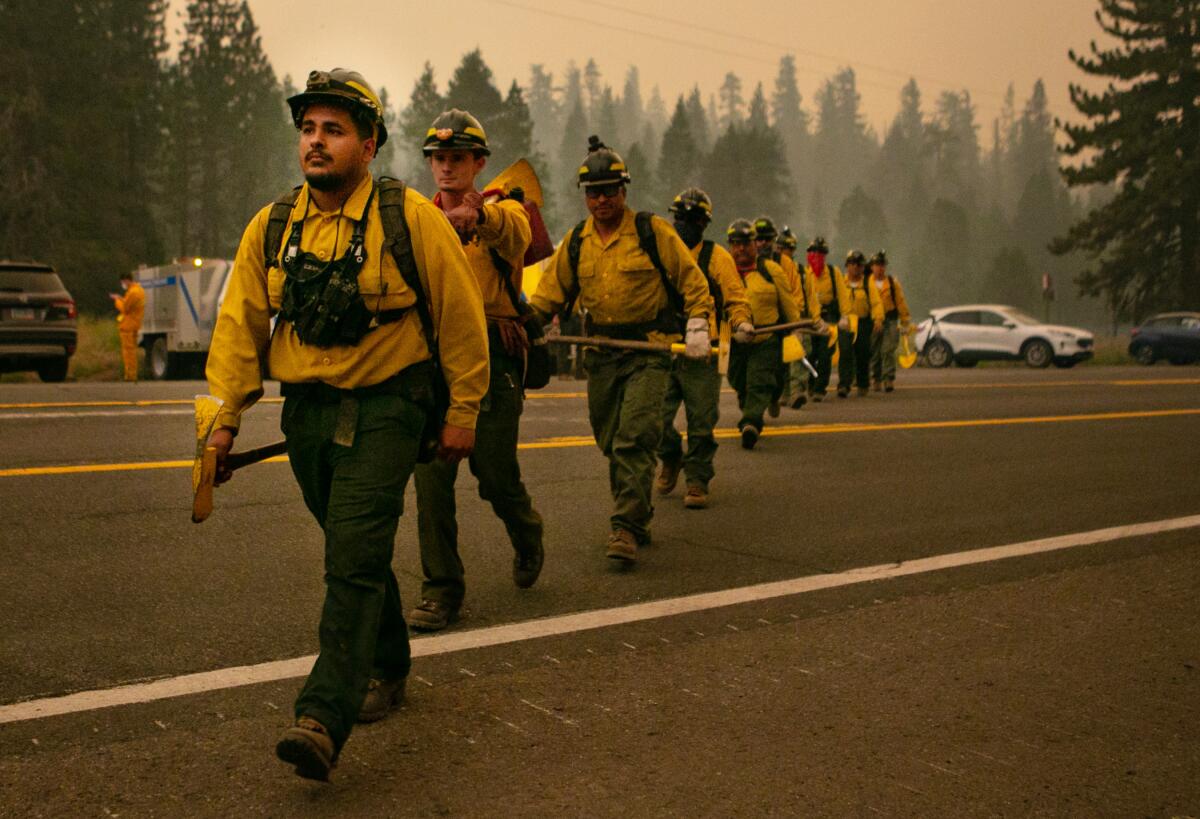
More than 43,400 Californians have been told to evacuate from their homes amid the state’s worsening conflagrations, said Mark Ghilarducci, director of the California Governor’s Office of Emergency Services.
“We know these are difficult times, and we continue to be all hands on deck,” he said.
The forested area where the Caldor fire is burning has been beset by fire before. In the mid-1800s, the rise of steam-powered logging equipment, lumber mills and railroads increased the potential for fires to ignite. Newspaper accounts in the 1880s told of whole towns being destroyed.
Tahoe City, which then consisted of about 50 houses, two hotels and some stores, burned down in 1894, according to The Los Angeles Times’ archives. Another fire in 1898 burned from the Rubicon area back in the mountains to the shore of the lake, destroying “a vast amount of valuable timber,” the archives state.
And many locals in South Lake Tahoe said they still remember the Angora fire of 2007 — another wind-driven wildfire in El Dorado County that spurred evacuations and destroyed more than 200 homes. Officials blamed high winds and low humidity for the speed with which it swept through the area.
But that fire never grew much beyond 3,000 acres. The Caldor fire, by comparison, had seared through more than 177,000 acres by Monday morning, and it was only 14% contained.
Michael Hicks, who owns the historic Strawberry Lodge on Highway 50, was among the many area residents anxiously watching the fire’s path from afar.
“Hopefully they can save as much of the community as possible,” Hicks said. But, he added, that is “up to the winds and the firefighters.”
Times staff writers Chris Megerian and Anita Chabria contributed to this report.
More to Read
Start your day right
Sign up for Essential California for news, features and recommendations from the L.A. Times and beyond in your inbox six days a week.
You may occasionally receive promotional content from the Los Angeles Times.
